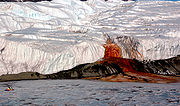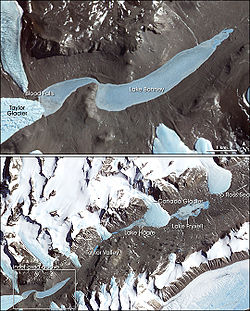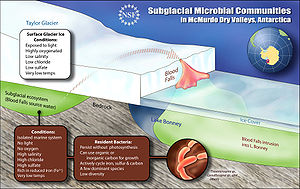
Blood Falls
Encyclopedia


Iron oxide
Iron oxides are chemical compounds composed of iron and oxygen. All together, there are sixteen known iron oxides and oxyhydroxides.Iron oxides and oxide-hydroxides are widespread in nature, play an important role in many geological and biological processes, and are widely utilized by humans, e.g.,...
-tainted plume
Plume (hydrodynamics)
In hydrodynamics, a plume is a column of one fluid or gas moving through another. Several effects control the motion of the fluid, including momentum, diffusion, and buoyancy...
of saltwater, occurring at the tongue of the Taylor Glacier
Taylor Glacier
The Taylor Glacier is an Antarctic glacier about long, flowing from the plateau of Victoria Land into the western end of Taylor Valley, north of the Kukri Hills, south of the Asgard Range...
onto the ice-covered surface of West Lake Bonney
Lake Bonney (Antarctica)
Lake Bonney is a saline lake with permanent ice cover at the western end of Taylor Valley in the McMurdo Dry Valleys of Victoria Land, Antarctica.It is long and up to wide...
in the Taylor Valley
Taylor Valley
Taylor Valley is the southern one of the three large Dry Valleys in the Transantarctic Mountains, Victoria Land, located west of McMurdo Sound at approximately . The valley extends from Taylor Glacier in the west to McMurdo Sound at Explorers Cove at the northwest head of New Harbour in the east...
of the McMurdo Dry Valleys
McMurdo Dry Valleys
The McMurdo Dry Valleys are a row of snow-free valleys in Antarctica located within Victoria Land west of McMurdo Sound. The region is one of the world's most extreme deserts, and includes many interesting features including Lake Vida and the Onyx River, Antarctica's longest river.-Climate:The Dry...
in Victoria Land
Victoria Land
Victoria Land is a region of Antarctica bounded on the east by the Ross Ice Shelf and the Ross Sea and on the west by Oates Land and Wilkes Land. It was discovered by Captain James Clark Ross in January 1841 and named after the UK's Queen Victoria...
, East Antarctica
East Antarctica
East Antarctica, also called Greater Antarctica, constitutes the majority of the Antarctic continent, lying on the Indian Ocean side of the Transantarctic Mountains...
.
Iron-rich hypersaline water sporadically emerges from small fissures in the ice cascades. The saltwater source is a subglacial pool of unknown size overlain by about 400 meters of ice at several kilometers from its tiny outlet at Blood Falls.
The reddish deposit was found in 1911 by the Australian geologist Griffith Taylor
Thomas Griffith Taylor
Thomas Griffith "Grif" Taylor was a British / Australian geographer, anthropologist and world explorer. He was a survivor of Captain Robert Scott's ill-fated Terra Nova Expedition to Antarctica .-Early life:...
, who first explored the valley that bears his name.
The Antarctica pioneers first attributed the red color to red algae
Red algae
The red algae are one of the oldest groups of eukaryotic algae, and also one of the largest, with about 5,000–6,000 species of mostly multicellular, marine algae, including many notable seaweeds...
, but later it was proven to be due only to iron oxides.
Geochemistry
Poorly soluble hydrous ferric oxides are deposited at the surface of ice after the ferrous ionFerrous
Ferrous , in chemistry, indicates a divalent iron compound , as opposed to ferric, which indicates a trivalent iron compound ....
s present in the unfrozen saltwater are oxidized
Redox
Redox reactions describe all chemical reactions in which atoms have their oxidation state changed....
in contact with atmospheric oxygen
Oxygen
Oxygen is the element with atomic number 8 and represented by the symbol O. Its name derives from the Greek roots ὀξύς and -γενής , because at the time of naming, it was mistakenly thought that all acids required oxygen in their composition...
. The more soluble ferrous ions initially are dissolved in old seawater trapped in an ancient pocket remaining from the Antarctic Ocean
Southern Ocean
The Southern Ocean comprises the southernmost waters of the World Ocean, generally taken to be south of 60°S latitude and encircling Antarctica. It is usually regarded as the fourth-largest of the five principal oceanic divisions...
when a fjord
Fjord
Geologically, a fjord is a long, narrow inlet with steep sides or cliffs, created in a valley carved by glacial activity.-Formation:A fjord is formed when a glacier cuts a U-shaped valley by abrasion of the surrounding bedrock. Glacial melting is accompanied by rebound of Earth's crust as the ice...
was isolated by the glacier in its progression during the Miocene period
Miocene
The Miocene is a geological epoch of the Neogene Period and extends from about . The Miocene was named by Sir Charles Lyell. Its name comes from the Greek words and and means "less recent" because it has 18% fewer modern sea invertebrates than the Pliocene. The Miocene follows the Oligocene...
, some 5 million years ago when the sea level was higher than today.
Unlike most Antarctic glaciers, the Taylor glacier is not frozen to the bedrock
Bedrock
In stratigraphy, bedrock is the native consolidated rock underlying the surface of a terrestrial planet, usually the Earth. Above the bedrock is usually an area of broken and weathered unconsolidated rock in the basal subsoil...
, probably, because of the presence of salts concentrated by the crystallization
Crystallization
Crystallization is the process of formation of solid crystals precipitating from a solution, melt or more rarely deposited directly from a gas. Crystallization is also a chemical solid–liquid separation technique, in which mass transfer of a solute from the liquid solution to a pure solid...
of the ancient seawater
Seawater
Seawater is water from a sea or ocean. On average, seawater in the world's oceans has a salinity of about 3.5% . This means that every kilogram of seawater has approximately of dissolved salts . The average density of seawater at the ocean surface is 1.025 g/ml...
imprisoned below it. Salt cryo-concentration
Eutectic point
A eutectic system is a mixture of chemical compounds or elements that has a single chemical composition that solidifies at a lower temperature than any other composition. This composition is known as the eutectic composition and the temperature is known as the eutectic temperature...
occurred in the deep relict seawater when pure ice crystallized and expelled its dissolved salts as it cooled down because of the heat exchange
Heat transfer
Heat transfer is a discipline of thermal engineering that concerns the exchange of thermal energy from one physical system to another. Heat transfer is classified into various mechanisms, such as heat conduction, convection, thermal radiation, and phase-change transfer...
of the captive liquid seawater with the enormous ice mass of the glacier. As a consequence, the trapped seawater was concentrated in brine
Brine
Brine is water, saturated or nearly saturated with salt .Brine is used to preserve vegetables, fruit, fish, and meat, in a process known as brining . Brine is also commonly used to age Halloumi and Feta cheeses, or for pickling foodstuffs, as a means of preserving them...
s with a salinity two to three times that of the mean ocean water. A second mechanism sometimes also explaining the formation of hypersaline brines is the water evaporation of surface lakes directly exposed to the very dry polar atmosphere in the McMurdo Dry Valleys. The analyses of stable isotopes of water allow, in principle, to distinguish between both processes as long as there is no mixing between differently formed brines.
Hypersaline fluid, sampled fortuitously through a crack in the ice, was oxygen-free and rich in sulfate
Sulfate
In inorganic chemistry, a sulfate is a salt of sulfuric acid.-Chemical properties:...
and ferrous ion. Sulfate is a remnant geochemical signature of marine conditions while soluble divalent iron likely was liberated under reducing conditions from the subglacial bedrock minerals weathered by microbial activity.
Microbial ecosystem

Ecosystem
An ecosystem is a biological environment consisting of all the organisms living in a particular area, as well as all the nonliving , physical components of the environment with which the organisms interact, such as air, soil, water and sunlight....
of autotrophic bacteria
Bacteria
Bacteria are a large domain of prokaryotic microorganisms. Typically a few micrometres in length, bacteria have a wide range of shapes, ranging from spheres to rods and spirals...
developed that metabolizes sulfate
Sulfate
In inorganic chemistry, a sulfate is a salt of sulfuric acid.-Chemical properties:...
and ferric
Ferric
Ferric refers to iron-containing materials or compounds. In chemistry the term is reserved for iron with an oxidation number of +3, also denoted iron or Fe3+. On the other hand, ferrous refers to iron with oxidation number of +2, denoted iron or Fe2+...
ions. According to geomicrobiologist
Geomicrobiology
Geomicrobiology is the result of the combination of geology and microbiology. The field of geomicrobiology concerns the role of microbe and microbial processes in geological and geochemical processes and vice-versa...
Jill Mikucki at Dartmouth College
Dartmouth College
Dartmouth College is a private, Ivy League university in Hanover, New Hampshire, United States. The institution comprises a liberal arts college, Dartmouth Medical School, Thayer School of Engineering, and the Tuck School of Business, as well as 19 graduate programs in the arts and sciences...
, water samples from Blood Falls contained at least 17 different types of microbes, and almost no oxygen. An explanation may be that the microbes use sulfate as a catalyst to respire with ferric ions and metabolize the trace levels of organic matter
Organic matter
Organic matter is matter that has come from a once-living organism; is capable of decay, or the product of decay; or is composed of organic compounds...
trapped with them. Such a metabolic process had never before been observed in nature.
A puzzling observation is the coexistence of Fe2+ and SO42–
Sulfate
In inorganic chemistry, a sulfate is a salt of sulfuric acid.-Chemical properties:...
ions under anoxic conditions. No sulfide
Sulfide
A sulfide is an anion of sulfur in its lowest oxidation state of 2-. Sulfide is also a slightly archaic term for thioethers, a common type of organosulfur compound that are well known for their bad odors.- Properties :...
anions (HS–
Sulfide
A sulfide is an anion of sulfur in its lowest oxidation state of 2-. Sulfide is also a slightly archaic term for thioethers, a common type of organosulfur compound that are well known for their bad odors.- Properties :...
) are found in the system. This suggests an intricate and poorly-understood interaction between the sulfur
Sulfur cycle
The sulfur cycle are the collection of processes by which sulfur moves to and from minerals and living systems. Such biogeochemical cycles are important in geology because they affect many minerals...
and the iron
Iron cycle
In ecology or geoscience, the iron cycle is the biogeochemical cycle of iron through landforms, the atmosphere, and oceans. The iron cycle affects dust deposition and aerosol iron bioavailability..- References :...
biochemical cycles.
Implications for the Snowball Earth hypothesis
According to Mikucki et al. (2009), the now-inaccessible subglacial pool was sealed off 1.5 to 2 million years ago and transformed into a kind of "time capsule," isolating the ancient microbial population for a sufficiently long time to evolve independently of other similar marine organisms. It explains how other microorganisms could have survived when the Earth (according to the Snowball EarthSnowball Earth
The Snowball Earth hypothesis posits that the Earth's surface became entirely or nearly entirely frozen at least once, some time earlier than 650 Ma . Proponents of the hypothesis argue that it best explains sedimentary deposits generally regarded as of glacial origin at tropical...
hypothesis) was entirely frozen over.
Ice-covered oceans might have been the only refugia for microbial ecosystems when the Earth apparently was covered by glaciers at tropical latitudes during the Proterozoic
Proterozoic
The Proterozoic is a geological eon representing a period before the first abundant complex life on Earth. The name Proterozoic comes from the Greek "earlier life"...
eon
Eon
-Science:* Aeon, a very long time* Eon , a collective problem solving project* Eon Mountain, in Canada* A measure of time in the geologic time scale- Fiction :* Eon , by Greg Bear...
about 650 – 750 millions years ago.
Implications for astrobiology
This unusual place offers scientists a unique opportunity to study deep subsurface microbial life in extreme conditions without the need to drill deep boreholeBorehole
A borehole is the generalized term for any narrow shaft bored in the ground, either vertically or horizontally. A borehole may be constructed for many different purposes, including the extraction of water or other liquid or gases , as part of a geotechnical investigation, environmental site...
s in the polar ice cap
Ice cap
An ice cap is an ice mass that covers less than 50 000 km² of land area . Masses of ice covering more than 50 000 km² are termed an ice sheet....
, with the associated contamination risk of a fragile and still-intact environment.
The study of harsh environments on Earth is useful to understand the range of conditions to which life can adapt and to advance assessment of the possibility of life elsewhere in the solar system, in places such as Mars
Mars
Mars is the fourth planet from the Sun in the Solar System. The planet is named after the Roman god of war, Mars. It is often described as the "Red Planet", as the iron oxide prevalent on its surface gives it a reddish appearance...
or Europa
Europa (moon)
Europa Slightly smaller than Earth's Moon, Europa is primarily made of silicate rock and probably has an iron core. It has a tenuous atmosphere composed primarily of oxygen. Its surface is composed of ice and is one of the smoothest in the Solar System. This surface is striated by cracks and...
, an ice-covered moon of Jupiter
Jupiter
Jupiter is the fifth planet from the Sun and the largest planet within the Solar System. It is a gas giant with mass one-thousandth that of the Sun but is two and a half times the mass of all the other planets in our Solar System combined. Jupiter is classified as a gas giant along with Saturn,...
. Scientists of the NASA Astrobiology Institute
NASA Astrobiology Institute
The NASA Astrobiology Institute was established in 1998 by the National Aeronautics and Space Administration "to develop the field of astrobiology and provide a scientific framework for flight missions". The NAI is a virtual, distributed organization that integrates astrobiology research and...
speculate that these worlds could contain subglacial liquid water environments favorable to hosting elementary forms of life, which would be better protected at depth from ultraviolet
Ultraviolet
Ultraviolet light is electromagnetic radiation with a wavelength shorter than that of visible light, but longer than X-rays, in the range 10 nm to 400 nm, and energies from 3 eV to 124 eV...
and cosmic radiation
Cosmic ray
Cosmic rays are energetic charged subatomic particles, originating from outer space. They may produce secondary particles that penetrate the Earth's atmosphere and surface. The term ray is historical as cosmic rays were thought to be electromagnetic radiation...
than on the surface.
See also
- ExtremophileExtremophileAn extremophile is an organism that thrives in physically or geochemically extreme conditions that are detrimental to most life on Earth. In contrast, organisms that live in more moderate environments may be termed mesophiles or neutrophiles...
s (bacteria resistant to extreme conditions)- PsychrophilePsychrophilePsychrophiles or cryophiles are extremophilic organisms that are capable of growth and reproduction in cold temperatures, ranging from −15°C to +10°C. Temperatures as low as −15°C are found in pockets of very salty water surrounded by sea ice. They can be contrasted with thermophiles, which...
(bacteria resistant to cold)
- Psychrophile
- Cryoconcentration of hypersaline brineBrineBrine is water, saturated or nearly saturated with salt .Brine is used to preserve vegetables, fruit, fish, and meat, in a process known as brining . Brine is also commonly used to age Halloumi and Feta cheeses, or for pickling foodstuffs, as a means of preserving them...
s- Eutectic pointEutectic pointA eutectic system is a mixture of chemical compounds or elements that has a single chemical composition that solidifies at a lower temperature than any other composition. This composition is known as the eutectic composition and the temperature is known as the eutectic temperature...
- Freezing point depression
- Eutectic point
- Life on MarsLife on MarsScientists have long speculated about the possibility of life on Mars owing to the planet's proximity and similarity to Earth. Fictional Martians have been a recurring feature of popular entertainment of the 20th and 21st centuries, but it remains an open question whether life currently exists on...
External links
- Antarctic Photo Library
- Antarctic Sun Project
- Blood Falls, Antarctica's Dry Valleys (NASANASAThe National Aeronautics and Space Administration is the agency of the United States government that is responsible for the nation's civilian space program and for aeronautics and aerospace research...
Observatory) - Blood Falls Antarctica's Dry Valleys (USGS)
- Unusual Antarctic microbes live on a previously unsuspected edge (NSF, Press Release 09-070)
- Antarctic Microbes and the International Polar Year
- HarvardScience: Microbes thrive in harsh, isolated water under Antarctic glacier – Newfound iron-breathing species have lived in cold isolation for millions of years
- Dartmouth College, Department of Earth Sciences
- Newly discovered iron-breathing species have lived in cold isolation for millions of years
- The Dark Secret at Blood Falls (The New York TimesThe New York TimesThe New York Times is an American daily newspaper founded and continuously published in New York City since 1851. The New York Times has won 106 Pulitzer Prizes, the most of any news organization...
) - An organism survives Antarctica, and maybe Mars (Time)

